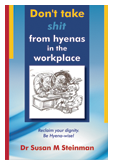
Definitions
Work trauma is the adverse effects and impact on the employee's physical and/or emotional wellness, health and safety as a result of physical and/or emotional violence experienced in the workplace.
These symptoms typically include, but are not limited to, external wounds and injuries and/or symptoms of Post Traumatic Stress Disorder (PTSD), excessive stress and/or stress-related illnesses. (Steinman, 2003)
Corporate Aggression refers to all situations where the majority of employees or any minority group feel subjected to unilateral conscious, calculated or planned negative actions, attitudes, rules and/or policies imposed by the employer to serve the employer's interests, in a situation where these employees feel that they are collectively unable to defend themselves and/or approach and/or reason with the source of aggression and/or effect any changes. (Steinman, 2002)
1. Definition of the term “Workplace Violence”
Workplace violence is defined as single or cumulative incidents where employee(s) are physically assaulted or attacked, are emotionally abused, pressurised, harassed or threatened (overtly, covertly, directly, indirectly) in work-related circumstances with the likelihood of impacting on their right to dignity, physical or emotional safety, well-being, work performance and social development.[1]Includes: Any physical violence such as an assault or attack and psychological or emotional violence such as threats, abuse, bullying/mobbing, sexual harassment and racial harassment.
GLOSSARY: Violence appears as physical violence or as psychological violence or structural violence in different forms, which may often overlap. Terms related to violence are defined in the following GLOSSARY
1.1 Physical Violence: The use of physical force against another person or group that results in physical, sexual or psychological harm.
Includes beating, kicking, slapping, stabbing, shooting, pushing, biting, pinching, strangling, among others.[2]
1.1.1 Assault/Attack: Intentional behaviour that harms another person or group physically, including sexual assault (i.e. rape).
1.2 Psychological Violence: Intentional use of power, including threat of physical force, against another person or group, that can result in harm to family life, livelihood, physical, mental, spiritual, moral or social development. [3]Includes verbal abuse, bullying/mobbing, harassment, intimidation and threats.
1.2.1 Abuse: Behaviour that humiliates, degrades or otherwise indicates a lack of respect for the dignity and worth of an individual.[4]
1.2.2 Bullying/Mobbing: Repeated and overtime offensive behaviour through vindictive, cruel or malicious attempts to humiliate, disrespect or undermine an individual or groups of employees and includes, but is not limited to psychological pressure, harassment, intimidation, threats, conspiracies, manipulation, extortion, coercion and hostile behaviour which could impact on the worth, dignity and well-being of the individual or groups.[5].
1.2.3 Harassment: Any conduct based on age, disability, HIV status, domestic circumstances, sex, sexual orientation, gender reassignment, race, colour, language, religion, political, trade union or other opinion or belief, national or social origin, association with a minority, property, birth or other status that is unreciprocated or unwanted and which affects the dignity of men and women at work.[6]
1.2.4 Sexual Harassment: Any unwanted, unreciprocated and unwelcome behaviour of a sexual nature that is offensive to the person involved, and causes that person to be threatened, humiliated, degraded or embarrassed.[7]
1.2.5 Racial harassment: Any implicit or explicit threatening conduct that is based on race, colour, language, national origin, religion, association with a minority, birth or other status that is unreciprocated or unwanted and which affects the dignity of women and men at work.[8]
1.2.6 Threat: Any implicit or explicit promised use of physical force or power (i.e. psychological force, blackmail or stalking), resulting in fear of physical, sexual, psychological harm or other negative consequences to the targeted individuals or groups.[9]
1.3 Structural Violence
The intentional use of power and/or organisational systems and structures or laws against an individual or entity (employer, management, shareholders, employee, group of employees, client, government, unions) to carry out a covert or unethical agenda, enforce change or indulge in unfair practices to the disadvantage of the affected individual or entity.
Includes but not limited to the disrespectful handling of changes in the organisation, unrealistic redistribution of workload, intimidation, policies, procedures, regulations, manipulation, coercion to act in a certain way and so on, exercised by an individual or entity. [10]
[1]Steinman, S: 2002-2007.
[2] Adapted from the World Health Organisation’s definition of violence.
[3] Adapted from the World Health Organisation’s definition of violence.
[4] Alberta Association of Registered Nurses
[5] Steinman, S: 2006
[6] Human Rights Act, UK
[7] ILO/ICN/WHO/PSI Joint Programme on Workplace Violence, 2001
[8]Adapted from Human Rights Act, UK
[9] ILO/ICN/WHO/PSI Joint Programme on Workplace Violence, 2001
[10] Susan Steinman, Workplace Dignity Institute, 2006
DEFINITIONS OF TERMINOLOGY OFTEN USED TO DESCRIBE THE EFFECTS OF WORKPLACE VIOLENCE
When referring and discussing the effects of workplace violence, four concepts are often used, sometimes interchangeably. These are S tress, Traumatic Incidents and Post Traumatic Stress Disorder (PTSD) and Work Trauma . The definitions for these terms are discussed below:
Post Traumatic Stress Disorder : First and foremost it is necessary to understand the concept "Post Traumatic Stress Disorder (PTSD). PTSD is a natural emotional reaction to a shocking and disturbing experience. It is a normal reaction to an abnormal situation.
Post Traumatic Stress Disorder is defined in the DSM-IV, the fourth edition of the American Psychiatric Association's Diagnostic and Statistical Manual. The DSM-IV international equivalent is the World Health Organization's ICD-10. A revision, DMS V is currently underway.
The category of Post Traumatic Stress Disorder, chronic or delayed (309.81) says" "The essential feature is the development of characteristic symptoms following a psychologically traumatic event that is generally outside the range of usual human experience. The characteristic symptoms involve re-experiencing the traumatic event; numbing of responsiveness to, or reduced involvement with, the external world; and a variety of autonomic, dysphoric or cognitive symptoms. 8
The emphasis on Post Traumatic Stress Disorder (PTSD) as a result of experiencing or witnessing physical violence has its origins in the initial research on PTSD. This had been undertaken with people who had suffered a threat to life e.g. combat veterans, victims of accident, disaster and other acts of violence. However, there is growing recognition that Post Traumatic Stress Disorder can result from many types of shocking, but not necessarily life-threatening experiences including an accumulation of smaller, individually non-life-threatening events. Therefore the ICD 10 definition of the World Health Organisation captures mental and physical trauma and "exposure" indicates witness as well as direct experiences: "Exposure to an exceptional mental or physical stressor, either brief or prolonged" 9 .
Stress : The internet-based Academic Press Dictionary of Science Technology defines Stress in terms of behaviour as "(1) an unusual environmental condition that causes physiological, emotional, behavioural, or cognitive changes in an individual and (2) the changes or effects resulting from such environmental demands". In terms of psychology the AP Directory defines stress as "(1) specifically, a physical or emotional reaction to a situation perceived as unfamiliar, threatening, harmful, and so on and (2) the negative situation itself. Another more universal definition: "Stress is defined as an imbalance between perceived environmental demands on the individual and his/her perceived response. 10 " Stress is therefore not something happening to the individual, but the way in which the individual responds to what happens. 11
Traumatic incidents : Mitchell (1983) defines a traumatic incident as any situation faced by victims, which cause them to experience unusually strong emotional reactions and have the potential to interfere with their ability to function either at the scene or later. This can be any type of unusual experience, which disrupts the victim's normal level of functioning and ability to cope. 12
1.Adapted from European Commission DG-V
2.Adapted from the World Health Organisation's definition of violence.
3.Adapted from the World Health Organisation's definition of violence.
4.Alberta Association of Registered Nurses
5.Human Rights Act, UK
6.Irish Nurses Organisation
7.Adapted from Human Rights Act, UK
8.Schulz, H., Van Wijk, T. and Jones, P. 2000. Trauma in Southern Africa. Understanding emotional trauma and aiding recovery. Traumatology Services International.
9.World Health Organisation. 1992. The ICD 10 Classification of Mental and Behavioural Disorder: Clinical Descriptions and Diagnostic Guidelines. Geneva.
10.Cooper, C.L. (ed.). 1991. Industrial and Organizational Psychology. Edward Elgar Publishing Limited, Vol. 2.
11.Schulz, H., van Wijk, T. and Jones, P et al
12.Ibid.
(Click on image below to go to our store)

Read more...
Victim Support
Go to the 'For Victims' section
on our website for tools
and information on bullying.

Employee Wellness Program
If you are an employer, you
can contact us to arrange
a employee wellness program
for your organisation.

Receive our monthly Newsletter
Fill in your e-mail below and receive
updated information and
interesting news about workplace
communication, career
inspiration, workshops, conferences,
website updates, programmes and training
and the Foundation's work.
Subscribe to the WorkcomNews